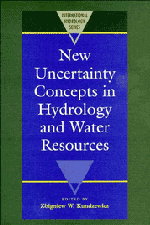Book contents
- Frontmatter
- Contents
- List of Authors
- Preface
- I INTRODUCTION
- II FACETS OF UNCERTAINTY
- III NOVEL APPROACHES TO UNCERTAINTY: FRACTALS, FUZZY SETS AND PATTERN RECOGNITION, NON-PARAMETRIC METHODS
- 1 Dispersion in stratified soils with fractal permeability distribution
- 2 Multifractals and rain
- 3 Is rain fractal?
- 4 Multifractal structure of rainfall occurrence in West Africa
- 5 Analysis of high-resolution rainfall data
- 6 Application of fuzzy theory to snowmelt runoff
- 7 On the value of fuzzy concepts in hydrology and water resources management
- 8 Application of neural network in groundwater remediation under conditions of uncertainty
- 9 Application of pattern recognition to rainfall–runoff analysis
- 10 Nonparametric estimation of multivariate density and nonparametric regression
- 11 Nonparametric approach to design flood estimation with pre-gauging data and information
- IV RANDOM FIELDS
- V TIME SERIES AND STOCHASTIC PROCESSES
- VI RISK, RELIABILITY AND RELATED CRITERIA
4 - Multifractal structure of rainfall occurrence in West Africa
Published online by Cambridge University Press: 07 May 2010
- Frontmatter
- Contents
- List of Authors
- Preface
- I INTRODUCTION
- II FACETS OF UNCERTAINTY
- III NOVEL APPROACHES TO UNCERTAINTY: FRACTALS, FUZZY SETS AND PATTERN RECOGNITION, NON-PARAMETRIC METHODS
- 1 Dispersion in stratified soils with fractal permeability distribution
- 2 Multifractals and rain
- 3 Is rain fractal?
- 4 Multifractal structure of rainfall occurrence in West Africa
- 5 Analysis of high-resolution rainfall data
- 6 Application of fuzzy theory to snowmelt runoff
- 7 On the value of fuzzy concepts in hydrology and water resources management
- 8 Application of neural network in groundwater remediation under conditions of uncertainty
- 9 Application of pattern recognition to rainfall–runoff analysis
- 10 Nonparametric estimation of multivariate density and nonparametric regression
- 11 Nonparametric approach to design flood estimation with pre-gauging data and information
- IV RANDOM FIELDS
- V TIME SERIES AND STOCHASTIC PROCESSES
- VI RISK, RELIABILITY AND RELATED CRITERIA
Summary
ABSTRACT Rainfall occurrence related to a particular location, denned as the set of rainy periods observed, can be regarded as a fractal object belonging to the 1-D space of time. The dimension of this object, which is bounded by 0 and 1, is estimated via the functional box counting method. A large number of West African rainfall time series has been analysed. The resulting dimension is a function of the time scale and of the accepted threshold of rainfall intensity. In all cases under study, for a given time scale, a decreasing fractal dimension of rainfall occurence with increasing rainfall intensity threshold was observed. A main time scale range of practical interest was found to be from some days to some months. It is possible to attribute a multifractal structure to the process of rainfall occurrence. It can be used for simulation and/or estimation purposes. Attempts to find regional patterns and trends, and to compare them to those of inter annual rainfall means were undertaken.
INTRODUCTION
In a given location, rainfall is an intermittent process. That means that, for this location, one can observe a succession of wet and dry states. These states must be carefully defined, with areal, time interval and threshold references. A time period would be defined as wet if a given area receives during a given time interval an amount of water greater than the given threshold.
A raingauge defines accurately an observed area, being its collection surface (generally 400 cm2).
- Type
- Chapter
- Information
- New Uncertainty Concepts in Hydrology and Water Resources , pp. 109 - 113Publisher: Cambridge University PressPrint publication year: 1995
- 8
- Cited by

